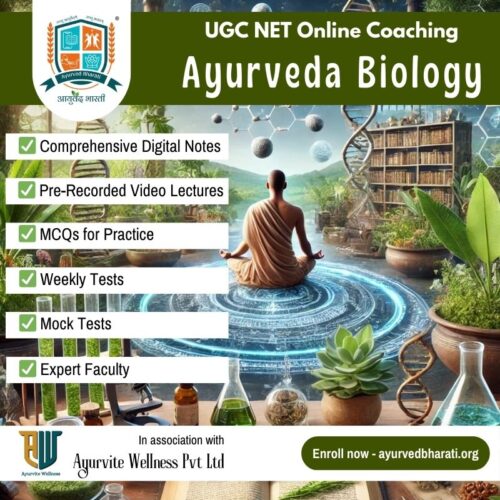UGC NET Ayurveda Biology coaching
- Course Validity: 12 months
- Resources: LMS and Digital Library Access – Pre-recorded video lectures in Hindi, Downloadable Digital Notes in English, MCQs & Mock Tests
- Content: Covers entire UGC NET Ayurveda Biology syllabus
- Language: Lectures – majorly in Hindi, Reading materials & test series in English
UGC NET Ayurveda Biology Coaching – Key Highlights
- Mode: 100% Online
- Study Materials: Comprehensive downloadable digital notes, pre-recorded videos, MCQs for practice, mock tests, printed book set of 3 books (can be purchased, not included in this course fee).
- Syllabus: Covers all 10 units recommended by UGC NET
- Expert Faculty: Experienced professionals specializing in Ayurveda and biology.
- Flexible Learning: Self-paced study with recorded lectures and accessible resources.
- Designed for Beginners & Experts: Tailored content for all levels of aspirants.
Click here for demo lessons/ videos
Limited Seats, have you booked your’s?
Q41. Arrange WBC types in increasing order of their count in normal human blood:
A. Neutrophils
B. Basophils
C. Lymphocytes
D. Monocytes
E. Eosinophils
Correct Ans – Option 3 (A, C, D, B, E)
Explanation –
From least to most in normal blood:
Basophils < Eosinophils < Monocytes < Lymphocytes < Neutrophils
Q42. Which of the following bond is NOT a part of the polynucleotide sequence?
Option A. Hydrogen bond
Option B. Phosphodiester bond
Option C. Amide bond
Option D. Glycosidic bond
Correct Ans – Option C (Amide bond)
Explanation –
Amide bonds are found in proteins (between amino acids), not nucleotides.
Polynucleotides contain:
- Phosphodiester bonds (sugar-phosphate)
- Hydrogen bonds (base pairing)
- Glycosidic bonds (sugar to base)
Q43. Correct sequence in Avaleha preparation:
A. Preparation of Kwatha
B. Reduction of mixture
C. Addition of sweetener
D. Addition of Prakshepa Dravya
E. Addition of honey
Correct Ans – Option 2 (A, C, D, B, E)
Explanation –
Steps in Avaleha (herbal jam):
- Prepare Kwatha
- Add sweeteners (Gud, sugar)
- Add Prakshepa
- Reduce mixture
- Add honey after cooling
Q44. Match the List-I with List-II (Dhatu vs Function):
| Dhatu | Function |
| A. Rakta | III. Preenana |
| B. Rasa | IV. Jeevana |
| C. Asthi | II. Dhaarana |
| D. Meda | I. Snehana |
Correct Ans – Option 3 (A-IV, B-III, C-II, D-I)
Explanation –
- Rakta – Jeevana
- Rasa – Preenana
- Asthi – Dhaarana
- Meda – Snehana
Q45. Sequence for use of Rasa in Ahara (Ayurvedic Diet):
A. Madhura
B. Amla, Lavana
C. Katu
D. Tikta
E. Kashaya
Correct Ans – Option 3 (A, B, C, D, E)
Explanation –
As per Ayurveda, the order of rasa intake should be:
Madhura → Amla → Lavana → Katu → Tikta → Kashaya
Q46. The neuromuscular junction has the following characteristics:
A. Activation of β-adrenergic receptors
B. Activation of Rynodine receptors
C. Activation of myosin light chain kinase
D. Opening of Nicotinic receptors
E. Entry of Na⁺ ions
Correct Ans – Option 1 (C, D, E Only)
Explanation –
At the neuromuscular junction,
- Nicotinic receptors open to allow Na⁺ influx,
- Leading to muscle contraction via myosin light chain kinase activation.
- β-adrenergic and ryanodine receptors are not directly involved at the junction level.
Q47. What is the full form of A-HMIS?
Option A. Ayurveda and Homeopathy medicine and Information System
Option B. Allopathy Health Management Information System
Option C. AYUSH Health Management Information System
Option D. Ayurveda Health Management Identification System
Correct Ans – Option C (AYUSH Health Management Information System)
Explanation –
A-HMIS is a digital platform under Ministry of AYUSH, designed to monitor and manage data related to Ayurveda, Yoga, Unani, Siddha, and Homeopathy.
Q48. Which among the following is NOT the disciple of Punarvasu Atreya?
Option A. Agnivesha
Option B. Bhela
Option C. Bharadwaja
Option D. Jatukarna
Correct Ans – Option C (Bharadwaja)
Explanation –
Bharadwaja was the disciple of Indra in ancient Ayurvedic lore, not Punarvasu Atreya, whose disciples include Agnivesha, Bhela, Jatukarna, etc.
Q49. Average weight of mice in an experiment (Control & Test):
Given Data:
Control weights: 32, 28, 26, 31, 33, 29
Test weights: 21, 28, 26, 25, 24, 22
Correct Ans – Option 2 (29.8 Control and 24.3 Test)
Explanation –
- Average control = (32+28+26+31+33+29)/6 = 29.8
- Average test = (21+28+26+25+24+22)/6 = 24.3
Q50. Correct sequence of number of nerves, veins, arteries, muscles, marma in body (Charaka):
A. Nine hundred
B. Two hundred
C. Seven hundred
D. Four hundred
E. One hundred and seven
Correct Ans – Option 2 (C, A, D, E, B)
Explanation –
As per Charaka:
- 700 veins,
- 900 nerves,
- 400 arteries,
- 107 Marma,
- 200 muscles

